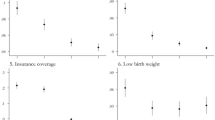Abstract
Objectives: This study sought to determine whether neighborhood impoverishment explains the racial disparity in urban postneonatal mortality rates. Methods: Stratified and multivariate logistic regression analyses were performed on the vital records of all African-Americans and whites born in Chicago by means of a linked 1992–1995 computerized birth–death file with appended 1990 U.S. census income and 1995 Chicago Department of Public Health data. Four community-level variables (low median family income, high rates of unemployment, homicide, and lead poisoning) were analyzed. Communities with one or more ecologic risk factors were classified as impoverished. Results: The postneonatal mortality rate of African-Americans (N = 104,656) was 7.5/1000 compared to 2.7/1000 for whites (N = 52,954); relative risk (95% confidence interval) equaled 2.8 (2.3–3.3). Seventy-nine percent of African-American infants compared to 9% of white infants resided in impoverished neighborhoods; p < 0.01. In impoverished neighborhoods, the adjusted odds ratio (controlling for infant and maternal individual-level risk factors) of postneonatal mortality for African-American infants equaled 1.5 (0.5–4.2). In nonimpoverished neighborhoods, the adjusted odds ratio of postneonatal mortality for African-American infants equaled 1.8 (1.1–2.9). Conclusions: We conclude that urban African-American infants who reside in nonimpoverished neighborhoods are at high risk for postneonatal mortality.
Similar content being viewed by others
REFERENCES
Guyer B, Hoyert J, Freedman M, Strobino D, Sondik E. Annual summary of vital statistics-trends in the health of Americans during the 20th century. Pediatrics 2000;106:1307–17.
United States Department of Health and Human Services. The initiative to eliminate racial and ethnic disparities in health. Retrieved May 29, 2000, from http//raceandhealth.hhs.gov.
Khoury M, Erickson J, Adams M. Trends in postneonatal mortality in the United States, 1962 through 1978. JAMA 1984;252:367–72.
Scott C, Iyasu S, Rowley D, Atrash H. Postneonatal mortality surveillance-United States, 1980-1994. MMWR 1998;47:15–28.
Stockwell D, Swanson D, Wicks J. Economic status differences in infant mortality by cause of death. Public Health Rep 1988;103:135–42.
Druschel C, Hale C. Postneonatal mortality among normal birth weight infants in Alabama, 1980-1993. Pediatrics 1987;89:335–41.
Kim B, Lee K, Khoshnood B, Hsieh H, Chen T, Mittendorf R. Impact of increased neonatal survival on postneonatal mortality in the United States. Paediatr Perinat Epidemiol 1996;10:423–31.
National Research Council. A common destiny. Blacks and American society. Washington, DC: National Academy Press, 1989.
Collins J, Schulte N, Drolet A. Differential effect of ecologic risk factors on the low birthweight components of African-Americans, Mexican-Americans, and non-Latino white infants in Chicago. J Natl Med Assoc 1998;90:223–32.
O'Camero P, Xue X, Wang M, Caughy M. Neighborhood risk factors for low birthweight in Baltimore: A multilevel analysis. Am J Public Health 1997;87:1113–8.
Rauh V, Andrews H, Garfinkel R. The contribution of maternal age to racial disparities in birthweight: A multilevel perspective. Am J Public Health 2001;91:1815–24.
Pearl M, Braveman P, Abrams B. The relationship of neighborhood socioeconomic characteristics to birthweight among 5 ethnic groups in California. Am J Public Health 2001;91:1808–14.
World Health Organization. Manual of the international statistical classification of diseases, injuries, and causes of death, based on the ninth revision conferences, 1975. Geneva: World Health Organization, 1977.
Collins J, Shay D. Prevalence of low birth weight among Hispanic infants with United-States born and foreign-born mothers: The effect of urban poverty. Am J Epidemiol 1994;39:184–92.
Schessalman J. Case-control studies: Design, conduct, and analysis. New York: Oxford University Press, 1982.
SAS User's guide, version 6, 4th edn, Vol 1. Cary, NC: SAS Institute Inc, 1989.
LaVeist T. Linking residential segregation to the infant-mortality race disparity in the U.S. cities. Sociol Soc Res 1989;73:90–4.
Polednak A. Black-white differences in infant mortality in 38 standard metropolitan statistical areas. Am J Public Health 1991;81:1480–2.
Polednak A. Trends in U.S. urban black infant mortality, by degree of segregation. Am J Public Health 1996;86:723–6.
Collins J, Herman A, David R. Prevalence of very low birth weight in relation to income-incongruity among African-American and white parents in Chicago. Am J Public Health 1997;87:414–7.
Johnson C, Borkowski M, Hunter K, Zunker C, Waskiewicz K, Evans J, Hether N, Coletta F. Infant sleep position: A telephone survey of inner-city parents of color. Pediatrics 1999;104:1028–211.
Read J, Troendle J, Klebanoff M, Infectious disease among infants in the United States, 1983 through 1987. Am J Public Health 1997;87:192–8.
Brett K, Schoendorf K, Kiely J. Differences between black and white women in the use of prenatal care technologies. Am J Obstet Gynecol 1994;170:41–6.
Kogan M, Kotelchuck M, Alexander G, Johnson W. Racial disparities in reported prenatal care advice from health care providers. Am J Public Health 1994;84:82–8.
Brenner R, Overpeck M, Trumble A, DerSimonian R, Berendes H. Deaths attributable to injuries in infants, United States 1983-1991. Pediatrics 1999;103:968–74.
Overpeck M, Brenner R, Trumble A, Trifiletti L, Berendes H. Risk factors for infant homicide in the United States. N Engl J Med 1998;339:1211–6.
Morgenstein H. Use of ecologic analysis in epidemiologic research. Am J Public Health 1982;72:1336–44.
Susser M. The logic in ecological I. The logic of analysis. Am J Public Health 1994;84:825–9.
Schwartz S. The fallacy of the ecological fallacy: The potential misuse of a concept and consequences. Am J Public Health 1994;84:819–24.
Author information
Authors and Affiliations
Rights and permissions
About this article
Cite this article
Papacek, E.M., Collins, J.W., Schulte, N.F. et al. Differing Postneonatal Mortality Rates of African-American and White Infants in Chicago: An Ecologic Study. Matern Child Health J 6, 99–105 (2002). https://doi.org/10.1023/A:1015464207740
Issue Date:
DOI: https://doi.org/10.1023/A:1015464207740




